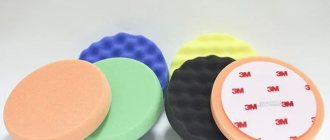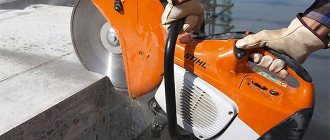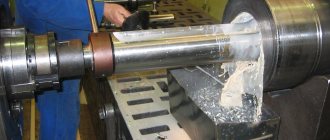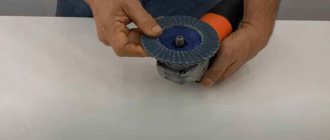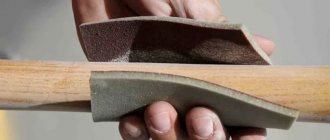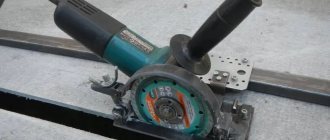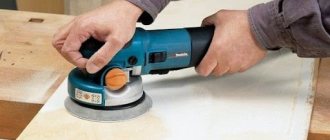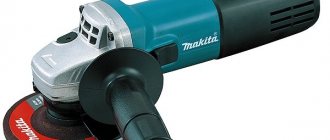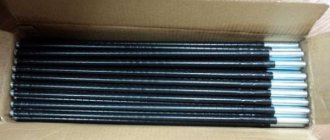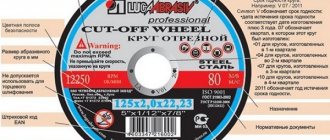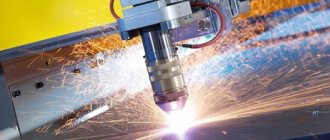Types of discs for grinders
Diamond blade - For the manufacture of such disks, diamond-coated steel is used. It can cut any metal, cut various types of natural stones and artificial stones.
A diamond blade can be used to cut glass and ceramics. It is important to make several shallow cuts when working. This circle cut is narrow and neat.
There are new polishing wheels on sale; they have an elastic base. The new items have a non-smooth surface that resembles a turtle shell, hence the name: “Turtle”.
Carbide disc - Discs are made from high-alloy steel with the addition of chromium, nickel and molybdenum. The successful combination of these metals with steel gave this type of disc mechanical strength, thermal strength, and resistance to corrosion and oxidation. I mainly use carbide blades to process aluminum, high-carbon steel, and sometimes wood.
Abrasive disc (fiber wheel) - In the production of this type of disc, the basis is latex paper or fiber. An abrasive material, such as aluminum oxide or silicon carbide, is applied to such a base. The abrasive disk is connected to a support plate; it is needed to stop the cooling of the abrasive.
These discs are used both for cutting and for stripping and stripping. The fiber wheel is suitable for any material: iron, wood, stone, concrete. They can remove old paint, scale and even carbon deposits from any surface.
TOP 5 best discs for grinders for metal (cutting)
Review and characteristics of the best discs for grinders for metal (cutting).
BOSCH Standard for Metal 2608603165, 125 mm 1 pc.
Cutting disc made from purified aluminum oxide (low iron, chlorine and sulfur) to cut metal with confidence.
A worthy German consumable for cutting high-alloy steels (including 5 mm metal).
Installed on the flange of the grinding machine (with the corresponding indicators).
It has a direct design, dry cutting type (this means that even in conditions without additional liquid cooling, the disc will perform its duties efficiently).
The materials are safe for humans. Fastening type - M14. Country of origin: Germany.
Specifications:
- bore diameter: 22.23 mm;
- thickness: 1.6 mm;
- maximum number of revolutions: 12250 revolutions in 60 seconds;
- packaged weight: 0.040 kg;
- packaging dimensions: 125x125x1 mm.
Advantages
- high level of productivity;
- straight cut;
- Excellent value for money and quality;
- widely spread;
- serves for a long time.
Flaws
- the price is “biting”;
- vibration is felt.
BOSCH Standard for Inox - Rapido 2608603171, 125 mm 1 pc.
The Standard for Inox cutting disc is a reliable choice for working with stainless steel.
Made from aluminum oxide. Ideal for angle grinders of the same brand.
Makes a neat cut of the required depth. The mounting hole corresponds to a nominal value of 22.2 mm.
The shape is straight, the number of revolutions per minute is decent - 12250.
The material does not harm humans. The disc weighs very little - only 0.04 kg, so it does not put a lot of stress on the hand. The birthplace of the brand and place of assembly is Germany.
Specifications:
- thickness: 1 mm;
- diameter: 125 mm;
- length: 125 mm;
- width: 125 mm;
- height: 2 mm.
Advantages
- no sulfur, ferrous and chloride fillers;
- high quality;
- lasts longer than cheaper analogues;
- convenient packaging;
- meet all safety requirements EN 12413.
Flaws
- fragile disk;
- Suitable for steel only;
- the price is higher than similar consumables.
BOSCH Multi Wheel 2608623013, 125 mm 1 pc.
A unique disc for working with plastic, plywood, wood, copper pipes, and drywall.
It cuts wood like butter - quickly and accurately, and the speed does not depend on the species (apricot, acacia, birch, oak - it copes with all of them without any difficulties).
The disc is segmented, the teeth are not clogged with wood chips. Resin can be removed using a regular brush and detergent.
On the surface there is a lot of abrasive mass (carbide chips), securely soldered with a laser.
Anti-vibration slot provides unique cutting speed and prevents blade deformation.
Specifications:
- bore diameter: 22.23 mm;
- thickness: 1 mm;
- purpose: dry cutting;
- maximum number of revolutions: 12250 per minute.
Advantages
- thin cut;
- versatility in use;
- good quality of work;
- does not become rusty;
- inexpensive.
Flaws
- even at low speeds the plastic overheats in the process;
- if you cut nails, it loses abrasive chips;
- Sometimes the cuts turn out crooked.
BOSCH Rapido Multi Construction 2608602385, 125 mm 1 pc.
Another German cutting disc that, like a superman, copes with aluminum, and tin sheets, and brick walls, and with PVV.
Fittings, plastic corners, corrugated sheets, water pipes, mesh, concrete, stone, marble - there is no material to which you can say “stop, it won’t work.”
The chrome remains smooth, without scorch marks, the master does not have to worry about sparks - there are none either.
There are no special requirements for the grinding machine: a regular standard model with the ability to adjust the speed will do (you need medium or slightly higher).
The cuts are made quickly, silently and dust-free. The shape is straight. Specification - C 60 T BF.
Specifications:
- maximum peripheral speed: 80 m/s;
- thickness: 1 mm;
- bore diameter: 22.23 mm;
- highest speed: 12250 rpm.
Advantages
- smooth cuts on any material;
- few sparks;
- versatility;
- high-quality execution;
- does not “catch” the material.
Flaws
- Expensive;
- metal cuts worse than others.
Metabo SP-Novorapid INOX 617168000, 230 mm 1 pc.
A high-quality and reliable cutting wheel, which a hand cutter cannot find better.
The manufacturer is the German company Metabo, which produces and sells professional power tools.
Indispensable in manipulating thin-walled materials: stainless steel, profiles, pipes, sheet metal, wire.
Judging by the reviews on specialized sites, this circle has a considerable service life and high productivity.
It cuts through P65 rails and 80/80 pipes with 3 mm walls with a bang. One copy is included in the package.
Specifications:
- diameter: 230 mm;
- bore diameter: 22.23 mm;
- thickness: 1.9 mm;
- maximum number of revolutions: 6650 in 60 seconds.
Advantages
- inexpensive;
- ergonomic;
- lasts a long time;
- takes up little space;
- affordable.
Flaws
- rarely on sale;
- sometimes the middle is pressed through.
Each type of work has its own disk
It is important to use your own disk for each type of work. Cutting wheels cannot be used for stripping and vice versa. Based on this, it is possible to divide the types of disks by type of work.
- If it is necessary to cut or saw, then use cutting discs.
- If you have to cut wood products, use saw blades.
- If you need to peel off old layers of paint and varnish materials and primer or make the surface smooth, you need a roughing or grinding disc.
- You can process metal, wood, and plastic products with a flap disc.
- For final polishing of surfaces, a polishing disc is best.
Purpose of discs and attachments
Grinder circles differ in purpose for:
- cutting;
- roughing
- grinding;
- sharpening
Cutting discs
The most common task performed with a grinder is cutting various materials. The choice of tool material also depends on what material will need to be cut.
- Metal cutting. The metal cutting disc is made from crystalline alumina corundum, as well as from synthetic corundum called electrocorundum. The main color of metal cutting wheels is blue.
- Cutting stone and concrete. To cut stone, you should choose a disk made of another abrasive material - silicon carbide. This abrasive easily cuts white brick (silicate) and slate. But to cut red brick, some types of concrete or ceramic tiles, this wheel material is not suitable. Stone discs are available in green.
- Cutting ceramic tiles, red brick, porcelain tiles and concrete. A diamond disc is already used for these purposes. This attachment is made of metal; an abrasive mass with diamond chips is applied to the cutting edge. The picture above shows a segmented saw blade designed for dry cutting of material. All-metal discs require water cooling during operation.
- Wood cutting. Although there are saw blades for wood on sale that are no different from circular saw blades, it is better not to use them for safety reasons. When working with such a tool, the user often suffers serious injuries due to jamming, rebounding, accidental slipping of the tool, etc.
Therefore, if you are still going to use a saw blade on wood, you should adhere to safety precautions. The grinder must have a protective casing and handle installed, and the user must wear a protective mask or goggles. In addition, you cannot cut materials with this tool that are not intended for it.
The safest are considered to be wood discs with a chainsaw chain installed at the end. If the tool jams, the chain remains in place and the disc rotates idle, which reduces the likelihood of injury to the user.
Roughing
If it is necessary to remove a layer of paint or other application, as well as rust from any surface, brushes are used. They come in disc form or in the form of a bowl with built-in metal wire.
The wire in these nozzles can be twisted or loose. Its thickness can also vary. The thicker the wire, the coarser the stripping, the stripping disc or cup-shaped attachment is used, and vice versa.
Grinding
Sanding discs and attachments are used for grinding and polishing various surfaces (metal, wood, plastic and others). Often a flap type grinding wheel is used for grinding. It consists of many “petals” made of sandpaper. The grit of sandpaper can be selected based on the required type of processing (finishing or roughing).
The sandpaper can also be attached to the nozzle using Velcro. Such a tool is screwed onto the angle grinder spindle.
For polishing surfaces, special wheels and attachments are produced that look like felt pads or fabric discs.
Sharpening
To sharpen a tool, sharpening machines (sharpeners) are usually used. But if you don’t have the latter, but have a grinder, then you can purchase a sharpening (grinding) wheel for it, which can easily sharpen almost any cutting tool.
The main difference between grinding wheels and cutting wheels is their thickness (at least 5 mm).
Metal discs
Cutting wheels for working with metal are made from a super-hard material that is chemical-resistant and extremely fire-resistant based on aluminum oxide.
Cutting wheels made from these materials can be of two types:
- Flat;
- Convex.
Discs with a convex center are used for cutting metal products very close to the wall.
To summarize: how to choose a disc for an angle grinder?
To properly buy a disc for an angle grinder, you need to:
- Know the maximum size of disks that your angle grinder can handle. You cannot take disks larger than the device allows.
- Know the maximum speed of the grinder . The higher the rotation speed of the angle grinder, the smaller the disk size it can work with.
- Processed material . There are discs for wood, metal and stone. There are universal ones that can cut almost anything.
- Socket size . The size of the wheel seat must correspond to the same parameter in the angle grinder.
- Manufacturer . Do not buy frankly cheap discs or unknown products like hot cakes in the school cafeteria, and the savings will be minimal.
Wood discs
Toothed or circular discs are installed on permanently mounted “grinders.” A special feature of such a disc is the presence of teeth on the outside tipped with carbide materials.
There are chain discs, they have a chain. Suitable for medium density wood. When working with such a wheel, you cannot cut wood with metal elements; the chain will quickly become dull when it comes into contact with them. Everything is like with saws.
Sometimes you need a blade that can cut all types of materials - this is a universal blade. The nozzle has the appearance of a regular disk with three additional teeth, tipped with hard metal.
The disc with a tungsten carbide edge has tungsten carbide coating on the outside. There are technological holes on the disk, they help remove heat during operation. This disc is suitable for wood and plastic. Working with such a disk makes it easier to encounter various metal objects, such as screws.
Grinder discs: characteristics of the cutting wheel
The most popular type of disc for an angle grinder is the cutting attachment. It is represented by a circle with a hole inside, which is reinforced with a special metal ring to securely fix the element on the angle grinder spindle.
There are two types of cutting wheels - abrasive and diamond. Particles of abrasive material are applied to the working surface of the first version of the disc, which are connected to each other using a binder. A reinforced mesh made of synthetic material is applied on top of such a coating, thanks to which the strength properties and safety of using accessories for an angle grinder are increased.
Important! During operation, the surface of the disk gradually wears off, so an attachment with wear of no more than 35% is suitable for effective operation.
The most popular disc for an angle grinder is considered to be cutting
The abrasive disc has an affordable price. Grinder wheels come in a wide range and can be used for working with metal, wood and stone. However, the disc wears out quickly. This is accompanied by the emission of sparks during its operation, which can cause a fire. When working with a metal cutting disc for an angle grinder, an unpleasant odor arises, which takes a very long time to dissipate, making the tool inconvenient to use indoors.
How to choose an abrasive cutting disc for an angle grinder
Abrasive chips have a certain level of grain size and hardness, which determines the quality of surface treatment. It can be formed from various materials, as evidenced by the product labeling. Zirconium alumina (“A”), electrocorundum (“AS”), or silicon carbide (“C”) can be used as an abrasive.
Grinder discs are available in sizes 115-230 mm (diameter), their thickness is 1-3.2 mm. The inner ring size is 22.2 mm. The size of the circle is selected depending on the type of tool.
Helpful advice! The most popular option, which is intended for household work, is a universal metal cutting disc for an angle grinder 125 mm.
Abrasive cutting discs for grinders have a diameter of 115-230 mm and a thickness of 1-3.2 mm
The choice of disk thickness depends on the type of metal. For aluminum and thin steel, a circle measuring up to 1.5 mm is used. For reinforcement and dense metal products, it is advisable to use a disk with a thickness of more than 2.6 mm.
Based on the characteristics of the disc, we can say that the smaller the thickness of the cutting wheel, the faster the cut, since the small area of the blade helps reduce its resistance. Thin bits heat up less and provide a smoother and cleaner cut, but such discs wear down faster.
Helpful advice! Thin disks are best suited for low-power angle grinders that are not designed for long-term operation.
Differences between cutting discs for metal, wood and stone
Cutting attachments are classified according to the type of material being processed. There are discs for grinders for stone, metal and wood. The first two options are no different in appearance. To choose the right consumables, you need to carefully consider the markings.
The cutting disc for concrete has a coating of diamond chips on the cutting edge
The differences between discs are the type of abrasive used and the composition of the base wheel.
Cutting discs for metal 125 mm (and other standard sizes) are manufactured in several stages. Initially, the process of mixing the resin with the base substance, which is used as cobalt, electrocorundum or diamond, occurs. Then special additives are added to the composition. The finished mass is poured into the mold. A galvanized steel ring is placed in its central part. The edge of the disk is reinforced with fiberglass mesh. The mold is placed in an oven, where the product hardens under high pressure for 24 hours.
Important! The surface of the disc for the grinder for metal 125 (and other sizes) is blue.
The grinder disc for concrete and tiles is made in the same way as for metal. There are options made of galvanized steel. A special feature of the products is the presence of a circle of diamond chips on the cutting edge. The abrasive size varies between 0.2-0.8 mm.
Cutting discs for wood can be either toothed or chain
Woodworking discs have fine teeth and a sharp edge along the entire rim of the product. The edge is coated with tungsten carbide. The teeth can be straight, beveled or trapezoidal. The first option is used for pine needles and soft woods. The last type of product is used for processing medium-density material. A disc with alternating beveled teeth is a universal option.
Stone discs
Stone cutting discs, also known as diamond discs, are used for cutting all types of stones. There are several types of discs with applied diamonds.
- Solid Discs - There is a continuous tape on the disc. Diamonds of non-natural, artificial origin are applied along the entire circumference of the tape. The disc is designed for high-precision cutting.
- Segmented discs - The disc has several technological holes or slots, this increases resistance to mechanical and temperature loads.
- This type of drive is more productive. The disc is designed for rough, not precise cutting.
- Turbo discs - To increase mechanical strength, improve heat dissipation and increase cutting speed, the disc has grooves on the sides of the rim. The disc cuts any mineral materials.
- Turbo segmented discs - Discs are characterized by high performance and versatility.
- Diamond blades differ not only in structure, but also in the cutting method. Can be dry cutting and wet cutting.
- Dry cutting - This method provides a more precise cut. But its disadvantage is a large amount of dust. This type of work requires good ventilation.
- Wet cutting - This kind of cutting involves water cooling due to a constant flow of liquid. The disadvantage of such discs may be the bulkiness of special equipment for supplying liquid.
Characteristic features of a diamond cutting disc for an angle grinder
A diamond cutting wheel is a steel disk with a cutting part coated with diamond chips and expansion grooves over its entire area. They act as teeth, thanks to which heat is removed and deformation stress is reduced. The slots are located strictly symmetrically, which eliminates vibration of the disc during operation. The mass of diamond chips is also balanced in diametrically opposite directions, which ensures high quality and uniform cutting.
Diamond particles are interspersed throughout the rim of the circle. They cover a rim made of zinc, tin, nickel or cobalt alloys. The way the diamonds are secured determines the purpose of the wheel. Using galvanic technology, such discs are designed for processing products made from soft natural stone. If laser welding or sintering is used, the wheel can be used for any type of solid material.
A diamond blade for a 125 mm grinder and other standard sizes can have a surface grit from 50 to 3000.
A diamond blade for an angle grinder can have a surface grit from 50 to 3000
A diamond disc has a number of distinctive advantages over a simple abrasive wheel. It has greater productivity, durability, performs high-quality and accurate cuts and shows long service life. When working with it, no sparks are formed and there is no strong odor.
Important! The diamond blade can be used on angle grinders with a speed of 12,000 rpm, but can also withstand 13,900 rpm, which is typical for professional machines.
This circle is afraid of overheating, so you need to take breaks when working with it. When using a non-segmented diamond blade for an angle grinder of 230 mm and smaller diameter, it is necessary to provide additional cooling with water. The disadvantage is also the high price of such consumables.
What types of discs are there with diamond chips on the surface?
For a cut diamond wheel for an angle grinder, monocrystalline (in the form of solid spatial structures of regular shape) or polycrystalline diamonds, which consist of several small single crystals firmly connected to each other, can be used. Concrete discs for grinders of 230 mm and smaller diameter, equipped with the first type of material, can be used for cutting hard materials, since they are more durable.
The surface of diamond wheels for grinders has different colors, for example, orange ones are intended for plaster and brick
Important! A diamond blade for a grinder for concrete can be used to make a straight cut, since with a curved trajectory the disk can lose diamonds or be destroyed completely.
The artificial diamonds on the rim of the disc can be evenly distributed or spaced at specific intervals. The last option is more productive. Such discs provide less force on the tool, promote uniform load distribution and more efficient cooling.
The outer surface of diamond grinder wheels can have different colors. Based on the decoding of the disc colors, blue frames have nozzles for concrete and marble, gray frames for ceramic products, green frames for granite, yellow frames for ceramics and plaster, orange frames for plaster and bricks.
Classification of diamond discs for concrete for grinders depending on the structure
Diamond wheels are primarily designed for working with non-metallic materials. They are used for cutting ceramics, concrete, glass, asphalt and brick. There are also diamond blades for metal grinders that can process thin material.
Segmented diamond blades have equal sized dividing slots
Diamond bits differ in structure, depending on which they are divided into solid, segmented, turbo and turbo-segmented. The first type of wheel is equipped with a continuous cutting band, which is located around the circumference. There are several rows of artificial diamonds on it. Such discs are used for grinders on tiles, ceramics and other materials for which precision cutting is important.
Segmented wheels have dividing radial slots of the same size in several working areas. This type of diamond disc is more resistant to temperature and mechanical loads and provides greater productivity. However, the cut is not as precise as when working with solid discs. In addition, they have a higher cost. This attachment is designed for deep cutting of concrete structures.
A distinctive feature of diamond turbo discs is the presence of oblique notches on the sides of the rim, which increases the mechanical strength of the wheel. It also helps to increase the intensity of heat removal, which allows you to speed up the cutting process by 75-100%. The turbo disc can be used to quickly cut various mineral materials of varying hardness.
The most productive discs are turbo segmented discs. The rim is divided into segments with a lateral turbo notch.
The presence of oblique notches on the sides is a distinctive feature of turbo discs
Diamond blades for grinders for concrete are also distinguished by method of use - for wet and dry cutting. The first type of product has a continuous solid surface. Before starting work, it should be moistened with water. When making a disc, bronze or cobalt is applied to its cutting edge. The first option is used for cutting granite and quartz, and the second is used for tiles and drywall.
Dry cutting discs have a surface divided into several segments around the entire perimeter. Diamond teeth are welded to the end of each strip. This circle exhibits increased resistance to overheating. Despite this, it should not be operated for more than 3 minutes. This blade is designed for cutting rock and concrete materials.
Grinding disc
Grinding discs come in a variety of shapes: flat and cup-shaped; by surface type: petal, wire, diamond, disc.
- Flap disk - used when working with wooden surfaces.
- Wire disc - used for stripping or removing rust.
- A diamond blade is good when working with stone. When working on stone or similar surfaces, use a bowl-shaped wheel.
- Disc disc - for grinding metal.
Instructions for replacing a disc on an angle grinder (step by step)
No matter how durable the circle is and is resistant to all kinds of influences, sooner or later it will need to be changed. Replacing a disk consists of several stages:
- Disconnect the grinder from the power source.
- Press the button that locks the spindle.
- Insert the key with the pins into the nut that secures the circle.
- Turn the wrench counterclockwise until the nut gives way. In this case, do not forget to hold the latch. As soon as the nut starts to move, you can tighten it by hand.
- Remove the nut from the spindle, then remove the used disc.
- Now you can safely put on the new disc.
- We perform all steps in reverse order. The nut does not need to be tightened with a wrench; it is enough to fix it manually.
- We plug in the tool and continue working.
How to unscrew a disc on an angle grinder if it is jammed
During operation, for one reason or another, a nuisance may occur - the disk may jam. We offer you two ways to solve this problem:
First way
- We find, in our arsenal, a piece of metal plate no more than 1 mm thick.
- Clamp the plate in a vice.
- Break the remaining disk. It's better to use pliers.
- We insert the plate between the upper nut, the one that secures the disk, and the lower nut.
- Let's start cutting.
- The remains of the disk between the nuts will wear off, and the nut will begin to move freely.
- Remove the nut
Second way
- We break the disk.
- Using a gas wrench, fix the lower nut so that the spindle does not rotate.
Using a standard wrench, we begin to unscrew the top nut. As soon as the top nut moves out of place, you can unscrew it by hand.
Typical disk sizes for angle grinders
All interchangeable wheels have standardized sizes, so for any model of grinder you can choose a suitable size disk, even if it is “non-original” (from another company). The table below shows the typical dimensions of cutting discs in terms of thickness, diameter of the circle and seat:
| Circle diameter, mm | Thickness, mm | Mounting socket, mm |
| 115 | 1,0; 1,6; 2,0; 2,5; 3,0; 3,2 | 22,00; 22,23 |
| 125 | 0,8; 1,0; 1,25; 1,6; 2,0; 2,5; 3,0; 3,2 | 13,20; 22,23 |
| 150 | 0,8; 1,0; 1,25; 1,6; 2,0; 2,5; 3,0; 3,2 | 13,20; 22,23 |
| 180 | 1,0; 1,25; 1,6; 2,0; 2,5; 3,0; 3,2; 4,0 | 22,23; 32,00 |
| 230 | 1,6; 2,0; 2,5; 3,0; 3,2; 4,0 | 22,23; 32,00 |
The larger the diameter of the circle and its thickness, the thicker the products it can cut. Please note that the diameter of the disc should not exceed the permissible size for a particular grinder model. Thus, a 230 mm disc cannot be placed on an angle grinder with a maximum allowable wheel size of 125 mm. Such actions will force you to remove the protection, which is a violation of safety regulations, and will lead to an increase in the linear speed of the cutting edge, which is why the disk can simply fly apart during operation and injure the operator.
The diameter of the seat in most grinders is 22.23 mm, 13.20 mm is less common, and the diameter of 32.00 is relevant only for large disks. Pay attention also to the linear speed of rotation of the disk. For example, if the disc’s marking indicates a speed of 13,000 rpm, this means that your grinder must also produce such revolutions in order to work with it.
You can understand what material the nozzle can work with and what its typical dimensions are by looking at its markings on the front side. If you came to the store and picked up the disc, you can see the following:
We would like to note that sometimes the buyer may encounter non-standard nozzle sizes, and this may apply to both diameter and thickness. This often happens when purchasing “no-name” disks of unknown manufacture. We still recommend buying branded discs, since unknown ones are erased faster, and in the end you have to pay more.
